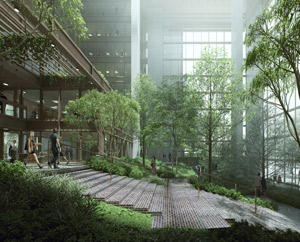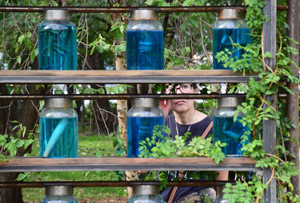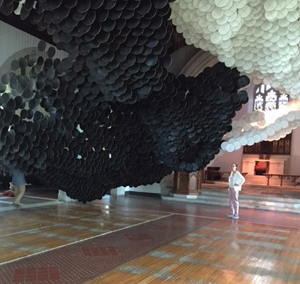Emerging to the Public
John Haberin New York City
— Something exciting happened at work today. We reconfigured the cubicles, and now I have a partial view of a potted plant.
— You're happy about seeing half a potted plant?
— I call it bringing the outside in.
— Scott Adams, Dilbert
The Ford Foundation and the Socrates Annual
The 2018 Governors Island Art Fair
I love exploring New York in the quiet of summer, when many have left for greener climes, but why stop there? Where else is every day a discovery—and where else, too, does more great architecture afford public access?
The Ford Foundation reopened in the dead of winter, bringing summer greenery indoors. And the year's choice of emerging artists in Socrates Sculpture Park keeps the issues alive as a long winter passes into spring.  Other discoveries began the very moment that summer sculpture departed the great outdoors. By early fall, the Governors Island Art Fair was giving its game away. Yes, it is an art fair, although an alternative fair, centered on rising artists and not galleries. Can it still find its strength in the site specific?
Other discoveries began the very moment that summer sculpture departed the great outdoors. By early fall, the Governors Island Art Fair was giving its game away. Yes, it is an art fair, although an alternative fair, centered on rising artists and not galleries. Can it still find its strength in the site specific?
Enclave and access
Every New Yorker has that special place to escape the chaos and to call one's own. For me growing up, it might have been Central Park, when much of the park was quieter and even dangerous, or my bedroom with a book. For me now, it might be the Frick Collection or just a crowded street where people pass never to be seen again. An entire city is like that—at once public and private, with its most public moments a private treat and its most private moments in full view. Not all of New York can promise at once an enclave and access, but the Ford Foundation can once again. And its two-year renovation dedicated itself to both.
I had remembered mostly the enclave. As one looks up from its atrium, offices rise higher and higher as if to envelop the viewer, each with a story or two of its own. Any glass and steel structure glows from within at night, but this one does even by day, thanks to warm lighting, reddish granite, and Cor-Ten steel. And it welcomes inside not just visitors, but an entire forest, as if the building itself were an ecosystem or a living thing. Kevin Roche and John Dinkeloo designed the architecture in 1967 and Dan Kiley the sunlit landscape. Sheila Hicks contributed wall panels in silk and linen.
Together, they created a space at once outdoors and in. Summer sculpture or the High Line has played on the ambiguity, but here it is embedded in architecture. Offices for the philanthropic organization surround the wooded courtyard on three sides, as if they were the part closer to outdoors, and then the glass fourth wall supplies illumination and a view of the street. (I shall always think of the building as part of 42nd Street, although one now enters from 43rd.) The ceiling's triangular bracing lets in more light, a literal highlight of my decade in architecture. Steel columns here and there heighten the sense that this is not unspoiled nature but a way of life.
That combination of warmth and Modernism recalls another lasting favorite—the Seagram Building on Park Avenue, by Mies van der Rohe, with much the same materials and shades. Can I ever quite excuse its bare plaza that provides a setback, but that pedestrians all but avoid? What if the plaza migrated indoors? At the Ford Foundation, it has, and it has brought greenery with it. A reflecting pool provides further occasion for, of course, reflection. With a location well east, past Second Avenue, I could always hope for a moment alone.
Renovation has heightened access. It appears symbolically in a move of the CEO's office further downstairs, in what is now the Ford Foundation Center for Social Justice. It appears practically in an art gallery and the wheelchair accessibility of today's public code. Still, the project sticks closely to the original. It again employs both architects for the structure, led by Madeline Burke-Vigeland of Gensler (most recently architects for the International Center of Photography), and the landscape, Jungles Studio. As I found my way to the glass entrance, the imposing granite walls reminded me how much the building also owes to the Brutalism of its time, like the Met Breuer.
Code governing safety and structural integrity also motivated the project. The team had to rethink the choice of vegetation, which brushed up against the glass and steel. Memory is deceptive, but I would like to think that nothing at all has changed. Will the garden still maintain a balance between the disorder of nature and the order necessary to preserve sightlines and to let in light? Will it still offer an enclave along with access? The test may come soon enough, in a city where word spreads fast.
A ruin or a promise
Carlos Jimenèz Cahua opens a show at Socrates Sculpture Park and does his best to hold it together. That would be impressive enough, but try not to stub your toe. Cahua leaves slabs on the ground just past the entrance, for what could be headstones, fragments of ancient monuments, or just plain studio debris. More concrete interrupts the work of others, in the form of slightly damaged stars.  Has he reconfigured a waterfront park in Queens as a graveyard like Alexandria Smith, a ruin, a promise, a moving testimony to Peruvian cultures and the costs of imperialism, or just a failure as public art? Even he, among fourteen others, can never quite find an answer.
Has he reconfigured a waterfront park in Queens as a graveyard like Alexandria Smith, a ruin, a promise, a moving testimony to Peruvian cultures and the costs of imperialism, or just a failure as public art? Even he, among fourteen others, can never quite find an answer.
The Socrates Annual testifies to a commitment to its neighbors. It features the park's sixteen artists in residence, although they have their outdoor studios elsewhere. (Residence in a park sounds slightly off anyway.) It allows them to think of their work as public and site specific, perhaps for the first time in their careers. If I have not reviewed previous incarnations, it could stand for many a show of emerging artists. It displays art as at once a physical presence and ever thoughtful, without always prompting visitors to think or to feel.
One should expect tough questions about home in an ethnically diverse show in an ethnically diverse neighborhood. (Astoria is no longer all Greek to me.) Joiri Minaya raises them as well with a simple shed covered with floral images. Step inside in fall or spring, and it seems barer still, while its vinyl becomes translucent and the grass outside seems to glow. The contrasts should seem all the starker and stranger in winter. One may have to turn one's back on nature to seek shelter from the storm (and a coming annual will even call itself "Sanctuary").
Should one also feel that one is spying on other visitors to the park? The question seems only fashionable, after shows of "Public, Private, Secret" and surveillance footage of a shopping mall by Eckhaus Latta. It is also the first sign that, even with the finest work on display, the answers may never cohere. Sherwin Banfield even calls his tribute to the borough's hip-hop stars, three gilded busts with the appearance of stacked speakers for pedestals, A Cypher in Queens. Nathaniel Cummings-Lambert constructs a dense maze from wooden fencing more out of the Wild West than the wilds of New York. It invites one in while keeping one out.
Other puzzles are less rewarding but visually compelling all the same. Nancy Nowacek divides the lawn with four hundred gilded sandbags, and it seems downright presumptuous to ask why. Leander Mienardus Knust uses solar energy to drive chemical reactions within shelves of glass jars, while the pipes rust. The transformation is slow but inevitable, but does it exemplify recycling or entropy? Ronen Gamil sets out far less inviting shelter than Minaya, with miniature tents of crushed aluminum cans. The poignancy of the homeless collides with a mild disgust at habits of consumption.
Still other puzzles are best passed over in silence. What are those twin silicone blobs by Nicholas Missel, and why are they The Real Deal? Can a car draped in a rusted sheet by Joe Riley and Audrey Snyder say half as much about outer borough body shops or the machine in the garden as Virginia Overton with comparable objects in the very same park just last summer? Can a seeming radio tower by Amy Brener really stand for a pink dress, and what do brute figures carved with a chain saw by Leilah Babirye have to do with LGBTQ art? One may stop asking questions halfway through from sheer impatience, but they seem only natural for a crowded group show of young artists. For all their promise, they are still questioning themselves.
Giving the game away
The Governors Island Art Fair has surrendered Castle Williams to the authorities for a display of the island's history—from a Native American fishing camp to a garrison, a Coast Guard base, and a park. It has also turned the more imposing Fort Jay over to an artist beyond the fair, for his "prehistory." David Brooks sets out rock and sand on a network of thin troughs, as Rock, Mosquito, and Hummingbird, like a slurry long since run dry. The fair (as of 2019, Portal GI) passes on the grand arch of Liggett Hall, too, but Jacob Hashimoto brings the passage onto the newly landscaped south of the island newly alive. Suspended above, hundreds of wood cubes and translucent disks bring it closer at once to a tunnel and the light. These summer-long projects literally outlast the fair, which holds court on weekends in September.
What that leaves is more than ever an art fair, more even than last year and in years past—in four buildings along Colonel's Row, with their rooms in place of single-artist booths. It just happens to unfold on an island, but then so does the Frieze art fair. It has additional works on the green outside, but so has Frieze as well. They already set the tone. They include altogether proper sculpture, like latticed "crystals" from Oki Fukunada and a thick pillar of blond wood by James Payne. They also introduce a penchant for activity and overstatement,  with an abandoned truck by Ben Quesnel and crushed auto parts by Aleksandr Razin right out of John Chamberlain.
with an abandoned truck by Ben Quesnel and crushed auto parts by Aleksandr Razin right out of John Chamberlain.
Razin's crush resolves soon enough into an enormous motorcycle without a rider. It is going nowhere fast, but it asserts itself all the same. So do most of the roughly one hundred artists indoors. Gabe Duggan fills a room with black thread, less like the Minimalism of Richard Tuttle than a spider web. Samuelle Green creates paper caves, while Tim Fite covers every inch of a room but the fireplace in black and white, for a kind of graphic novel without text. Cryptic messages from Hyunjung Rhee spill out from endless printouts like old rolls from an adding machine.
Works like these are site specific, but not in the sense of an appeal to the site's natural or military history. Rather, they evoke its abandonment. Colonel's Row held the island's spiffier quarters, but you would hardly know that today. A feathered arch with sound from Guangyu Wu and works on paper by Margot Spindelman pick up on peeling paint. Tubes from Megan Suttles swarm across a window, bringing out cracks that are not even there. Here to stand out is to blend in.
Artists always feel the pressure to stand out in a crowded fair. Projections onto white spheres by Motomichi Nakamura may lend them eyeballs, jaws, or shifting colors. They would come as light entertainment in many another setting, like an Infinity Room for Yayoi Kusama, but who am I to complain here? And more than a few respond to the former officer's housing by moving right in. Monica Delgado stocks a kitchen with her secret ingredients, while others bring bean-bag chairs (along with steel drums for gongs) and a crib. Good old painting and sculpture are still possible, like night scenes lit by the moon or fire by Chris Hernandez and tabletop plastic by Peter Stankiewicz (much akin to metal sculpture by an older namesake, Richard Stankiewicz), but the fair's heart lies elsewhere.
The most site-specific art of all belongs not to the fair, but to Hashimoto. He also allows a rare entry to the stone Chapel of St. Cornelius for The Eclipse. Paper "kites" float like clouds past the chapel's stained glass and rise like mushrooms from the floor. This year's fair can seem anonymous by comparison, but that, too, tells a story. On the lawn, Rosanne Ebner sets out ceramics like grave markers of sandy hues and irregular geometries. They lack inscriptions or, on opening weekend, so much as a label for the work and the artist, but visitors can etch them with their memories.

Renovation of the Ford Foundation was completed December 11, 2018, and open to the public in late February 2019, just days before Rocke's death, while its gallery opened March 4 and and the Socrates Annual ran at Socrates Sculpture Park through March 10, 2019. The 2018 Governors Island Art Fair ran through September 30, 2018, Jacob Hashimoto through October 31.




